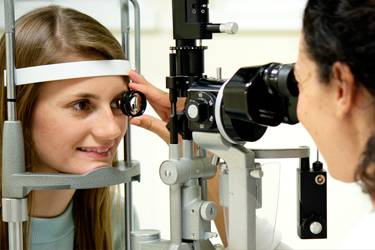Eye examination
An eye examination is a test where the specialist eye doctor (ophthalmologist) examines your eyes. They use a few different instruments to look at the eye internally and externally.
Why you might have it
You may have an eye examination to look at the different structures of your eye. This helps the doctor to check for changes or abnormalities.
Preparing for the test
You usually don’t have to prepare for an eye test. Your hospital letter will tell you if there is anything you have to do.
You may have drops into your eyes before the examination. These enlarge the pupils to make it easier for the eye specialist to look in your eyes.
The eye drops might sting a bit when they first go in. They can cause blurred vision, and your eyesight may be blurry for a few hours, so you shouldn't drive yourself home. It might be helpful to take a relative or friend to your appointment. Dilated pupils can also make your eyes more sensitive to sunlight. So bring a pair of sunglasses with you.
What happens?
The eye specialist will examine your eyes with a few different instruments. They look at the different structures of your eye to check for changes or abnormalities.
Ophthalmoscope
Your eye specialist might examine your eyes using a hand held device called an ophthalmoscope. This shines a light into the back of your eye. It usually takes a few minutes.

Slit lamp examination
You may also have your eyes examined with an instrument called a slit lamp. This is larger than the ophthalmoscope and sits on a table. This instrument has a bright light and powerful microscope so the doctor can look at the front and back of your eye in detail.
This test takes about 30 minutes. You usually have drops put into your eye to enlarge the pupils. You sit on a chair in front of the slit lamp and rest your chin and forehead on the instrument. This keeps your head steady during the test, so the doctor can have a clear view of the different parts inside your eyes. You often have photographs or digital images taken of your eyes. These are kept in your medical records.

After your examination
You can usually go home straight after your test.
Possible risks
An eye examination is a safe procedure, but there are a few things to remember:
- Your eyes may sting slightly from the eye drops to dilate your pupils.
- You may have blurred vision for 4 to 6 hours after you have had the eye drops.
- You may not be able to drive safely, so avoid doing so until your usual (normal) vision has returned.
- You may not be able to do tasks such as computer work or reading for a few hours.
- Your eyes can be sensitive to light for a short time afterwards. So bring a pair of sunglasses to your appointment to wear.
- If you normally wear contact lenses, you may be unable to put your lenses back in immediately. It may help to bring your glasses (spectacles), to use until you can put your lenses back in. This is usually around 30 minutes after this test.
Getting your results
You may have to wait to get the results.
Waiting for results can make you anxious. Ask your doctor or nurse how long it will take to get them. Contact the doctor who arranged the test if you haven’t heard anything after a couple of weeks.
You might have contact details for a specialist nurse and you can contact them for information if you need to. It may help to talk to a close friend or relative about how you feel.
You can also contact the Cancer Research UK nurses on freephone 0808 800 4040. The lines are open from 9am to 5pm, Monday to Friday.



